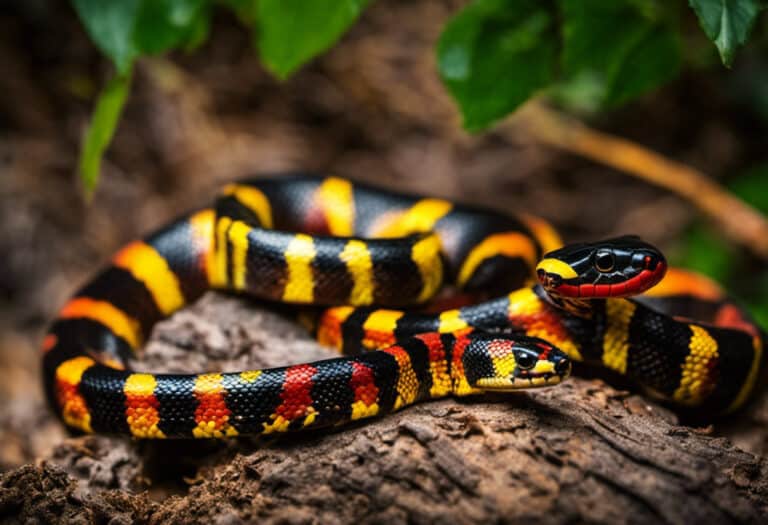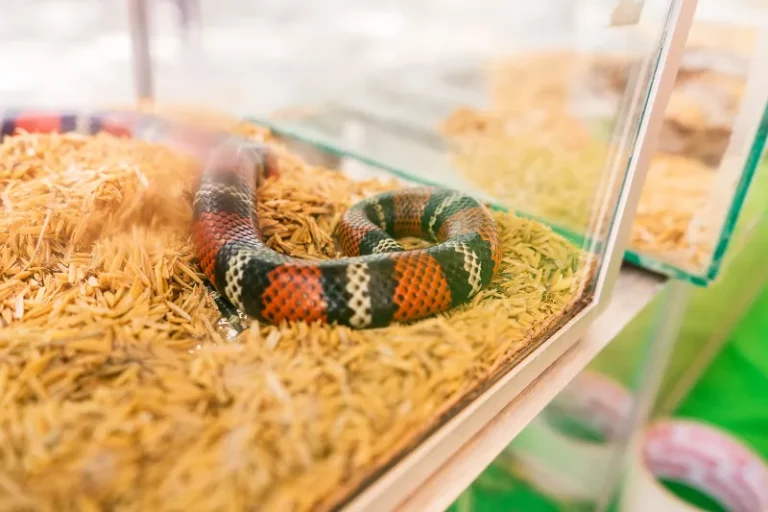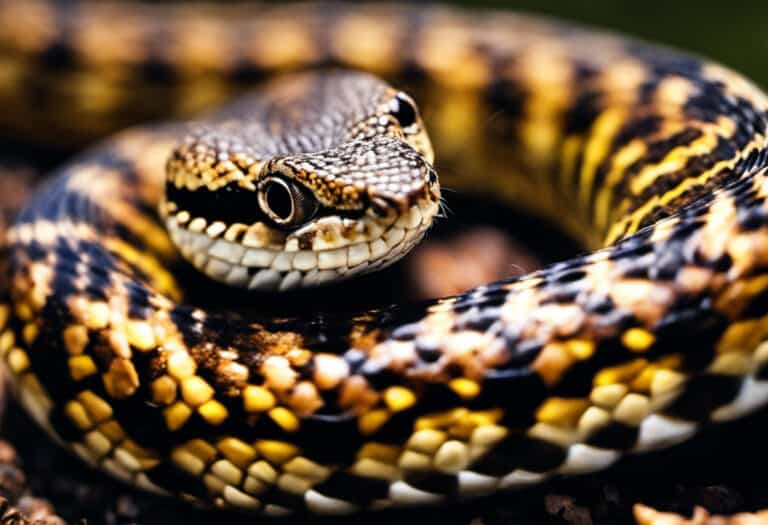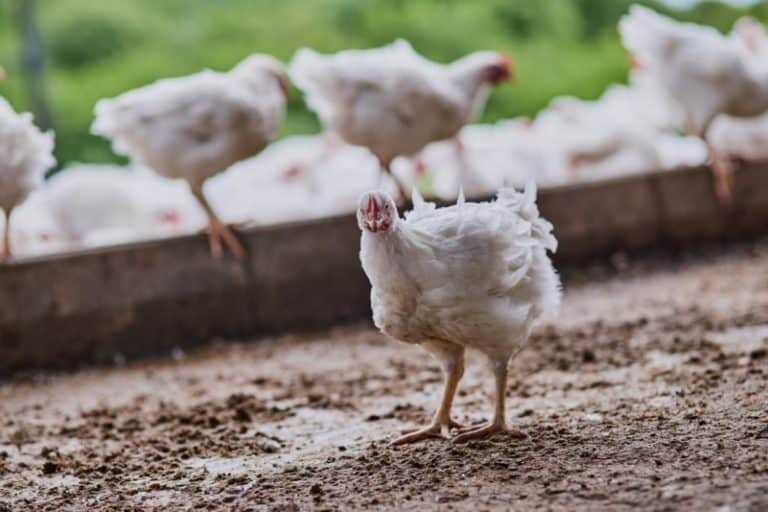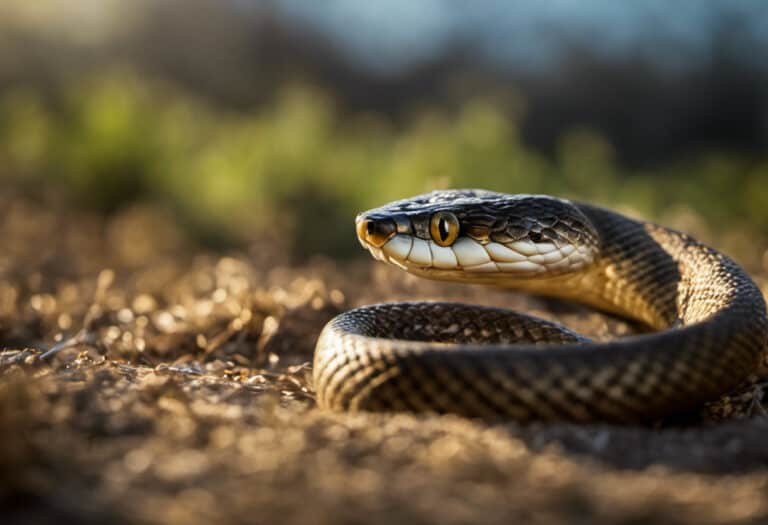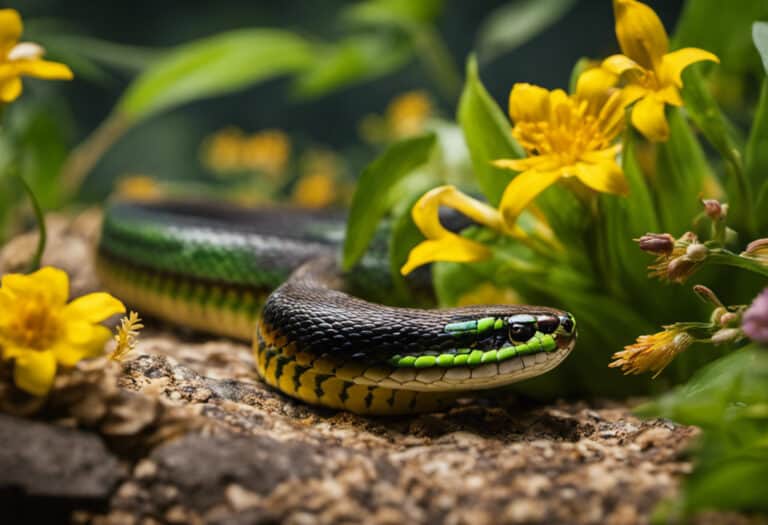Do Snakes Make Noise at Night?
Ever wondered if snakes make noise at night? Well, they do, and it’s not just hissing and rattling. In this article, we’ll dive into the fascinating world of snake vocalizations.
From the different sounds they produce to the reasons behind their nocturnal noises, we’ll explore it all. Discover how snakes communicate and defend themselves through a variety of sounds.
Plus, we’ll debunk common myths and give you tips for a peaceful night’s sleep.
So, if you’re ready to unravel the mysteries of snake noises, keep reading!
Key Takeaways
- Snakes make various types of noises, including hissing, rattling, shrieking, growling, and even farting, for communication, defense, and hunting purposes.
- Snakes may make noise at night as a defensive mechanism, for communication with other snakes and potential mates, to confuse or frighten prey, and to interact with other snakes despite impaired vision.
- Some nocturnal snake species known for making noise include rattlesnakes, pythons, vipers, Eastern hognose snakes, and the Saw-scaled Viper.
- Snake noises are produced through mechanisms such as exhaling air, vibrating segments of the tail, vocal cords, body vibrations, and rubbing body parts together.
Types of Sounds Snakes Make at Night
At night, snakes can make various types of sounds, such as hissing, rattling, shrieking, growling, and even farting, serving different purposes in their environment.
Snake vocalizations are a form of communication, allowing them to interact with each other and potential mates. These sounds also serve as a defense mechanism, especially when their vision is impaired at night.
The hissing sound is produced by snakes exhaling air through their glottis, while rattling is created by vibrating segments at the end of a rattlesnake’s tail. Some snakes with vocal cords can emit high-pitched shrieks, while others, like the Eastern Hognose snake, use body vibrations to simulate the growl of a larger predator.
And yes, snakes can even produce a cloacal popping sound, similar to farting, as a protective method.
Snake vocalizations at night play a crucial role in their social dynamics, hunting strategies, and overall survival in their environment.
Reasons Why Snakes Make Noise During Nighttime
Snakes make noise during nighttime for several reasons.
One reason is that it serves as a defense mechanism, especially when their vision is limited.
Snakes also use vocalizations as a means of communication with other snakes and potential mates.
Additionally, noise can give snakes an advantage during nocturnal hunting by confusing or frightening their prey.
Defensive or Communicative
When threatened or communicating with other snakes, snakes may use different sounds such as hissing, rattling, shrieking, growling, or farting. These sounds serve different purposes, depending on whether the snake is in a defensive or communicative mode.
During nighttime, when visual cues are limited, snakes rely more on their vocalizations to navigate their surroundings and interact with other snakes. Defensive sounds like hissing and rattling are used to deter potential threats and warn them to stay away.
On the other hand, communicative sounds such as growling and shrieking are used to establish territory, attract mates, and communicate with other snakes.
Understanding the dynamics of nocturnal communication in snakes helps shed light on their behavior and the importance of sound in their lives.
Advantage in Nocturnal Hunting?
To gain an advantage in nocturnal hunting, you should be aware that some snakes use sound to confuse or frighten their prey. The impact of noise on nocturnal hunting efficiency can be significant for these snakes. By utilizing vocalizations such as hissing, rattling, shrieking, growling, and even farting, snakes are able to disorient their prey and increase their chances of a successful hunt.
This strategic use of sound allows snakes to navigate in the dark and overcome the challenges posed by reduced visibility. By creating auditory distractions, they can effectively confuse their prey and strike with precision. This advantage in nocturnal hunting ensures that snakes can thrive in their nighttime ecosystems, where they play a crucial role in maintaining the balance of the ecosystem by controlling populations of rodents and other small animals.
Nocturnal Snake Species and Their Vocalizations
Certain nocturnal snake species, like pythons and vipers, may make hissing or shrieking sounds as a defense mechanism. These vocalizations are an important part of their nocturnal behavior, as they help snakes communicate, defend themselves, and enhance their hunting strategies.
Nocturnal snakes rely on their vocalizations to navigate and interact with their environment in the dark. By hissing or shrieking, they can scare off potential threats and confuse their prey, giving them an advantage during nighttime hunting.
Pythons, known for their powerful constricting abilities, may use hissing sounds to intimidate predators and protect themselves. Vipers, such as the African Bush Viper, can produce a specific shrieking sound to startle and deter potential predators.
Understanding the vocalizations and hunting strategies of these nocturnal snake species is crucial for appreciating their unique behaviors and the role they play in maintaining ecological balance.
Mechanisms of Snake Sounds in the Dark
When it comes to the mechanisms of snake sounds in the dark, there are a few key methods that snakes use to produce vocalizations.
Snakes exhale air through their glottis to create the hissing sound, while rattlesnakes vibrate segments at the end of their tail to produce a rattling sound.
Snakes with vocal cords can produce high-pitched sounds like shrieking or squeaking, and some snakes, like the Eastern hognose snake, create growling sounds through body vibrations.
Sound Production Methods
Snakes create sounds through various mechanisms, such as exhaling air to produce hissing or vibrating segments at the tip of their tail to create a rattling sound. These vocalizations serve several advantages for snakes, especially in terms of prey confusion.
By making noise, snakes can disorient and frighten their prey, giving them a strategic advantage during nocturnal hunting. The sound produced by snakes can confuse and startle their prey, making it easier for them to capture and consume their food.
Additionally, snake vocalizations can also serve as a means of communication between snakes themselves, allowing them to interact and coordinate with each other despite impaired vision at night.
Overall, snake noises play a significant role in their hunting and social dynamics, contributing to their survival and success in the wild.
Nocturnal Communication Mechanisms
When it comes to snake communication at night, you might be surprised to learn about their nocturnal vocalization behavior. Snakes, despite their reputation for being silent, do engage in vocalizations during nighttime hours. These vocalizations serve as an important mechanism for communication in the dark.
Snakes use these sounds to interact with other snakes and potential mates, as well as to defend themselves. The ability to vocalize at night allows snakes to maintain social dynamics and convey important messages despite the limitations of reduced visibility. By using various mechanisms such as hissing, rattling, shrieking, growling, and even farting, snakes have evolved to effectively communicate in the dark.
Common Myths and Misconceptions About Snake Noises
Snakes’ vocalizations come from mechanisms other than a voice box, debunking the misconception that they’ve the ability to make sounds like birds. Contrary to popular belief, snakes have unique ways of producing sounds that serve various purposes.
Here are some common myths and misconceptions about snake noises:
- Snakes don’t make sounds like birds; their vocalizations are unique to their species.
- Snakes don’t have a voice box to produce sounds; their vocalizations come from other mechanisms.
- Garter snakes don’t make noise; they rely on other defense mechanisms like musking.
- Snakes don’t make a clicking sound as part of their natural behavior.
- Snakes have limited hearing and may not be able to hear the sounds they produce.
Understanding the truth about snake vocalizations helps dispel misconceptions and contributes to a better understanding of these fascinating creatures.
Various Types of Snake Noises
You may be surprised to learn that snakes can produce a variety of different sounds, such as hissing, rattling, shrieking, growling, and even farting. These types of snake vocalizations play a significant role in their communication.
Hissing, for example, is a common sound produced by snakes when they feel threatened or are trying to defend themselves. Rattlesnakes, on the other hand, use their rattling sound as a warning signal to deter potential predators.
Some snakes with vocal cords can emit high-pitched shrieks to scare off enemies, while others, like the Eastern hognose snake, use body vibrations to simulate the sound of a larger predator’s growl.
Snakes also use vocalizations to communicate with each other and potential mates, especially at night when vision is reduced.
Snake Noises at Night or in Eluding Situations
When it comes to snake noises at night or in eluding situations, it’s important to understand that most snakes are diurnal and not active during the night. Therefore, the noises you hear are unlikely to be coming from snakes.
However, in certain circumstances, snakes may make specific sounds for particular reasons. For example, they may growl to scare away threats or grunt during copulation.
Nighttime Snake Vocalizations
Some snake species may vocalize at night as a means of communication and defense. Nocturnal snake behavior is an intriguing aspect of their survival strategies. Snake vocalization patterns during nighttime can serve multiple purposes.
Nighttime Snake Vocalizations:
- Communication: Snakes utilize vocalizations as a way to communicate with each other and potential mates, even in the dark.
- Defense Mechanism: Vocal cues act as a defensive mechanism, particularly at night when their vision is impaired.
- Hissing: Snakes exhale air through their glottis to produce a hissing sound, which can intimidate predators.
- Shrieking: Certain snake species with vocal cords can emit a high-pitched shriek to deter potential threats.
Understanding these snake vocalization patterns sheds light on the fascinating nocturnal behavior of these reptiles. It’s crucial to appreciate the freedom they possess in expressing themselves through sounds, allowing them to navigate their environment and ensure their survival.
Reasons for Snake Noises
When it comes to snake noises at night, there are two main reasons why they may occur: defensive mechanisms and communicative behavior.
Snakes rely on these nocturnal communication mechanisms due to reduced visibility in the dark.
Through vocalizations, they can defend themselves and interact with other snakes. To convey a deeper understanding, let’s explore a table showcasing the different snake noises and their respective purposes:
| Noise | Purpose |
|---|---|
| Hissing | Defense and communication |
| Rattling | Warning signal |
| Shrieking | Scare off potential enemies |
| Growling | Bluffing behavior when threatened |
| Farting | Protective method |
As you can see, these noises serve both defensive and communicative purposes, allowing snakes to navigate their environment and interact with others.
Understanding these nocturnal communication mechanisms is crucial for appreciating the freedom that snakes have in expressing themselves and ensuring their survival.
Snakes and Sound Perception
You may be wondering how snakes perceive sound and interpret the noises around them. Snakes have a remarkable ability to detect and localize sounds, even though they lack external ears. Here’s how they do it:
- Snakes and Sound Localization:
- Vibrations: Snakes can sense vibrations through their jawbones, allowing them to detect the direction of a sound source.
- Sensitive Scales: Specialized scales on their bodies, known as the ‘sublabial scales,’ help snakes pick up low-frequency sounds and vibrations from the ground.
- Impact of Noise Pollution on Nocturnal Snakes:
- Disruption of Hunting: Noisy environments can interfere with a snake’s ability to detect prey, especially during nighttime when they rely heavily on sound cues.
- Communication Interference: Excessive noise can disrupt snake-to-snake communication, affecting their mating rituals and social interactions.
- Stress and Disorientation: Loud noises can cause stress and disorientation in nocturnal snakes, leading to potential health issues and decreased survival rates.
Understanding how snakes perceive sound and the negative impact of noise pollution on nocturnal snakes is crucial for their conservation and well-being in their natural habitats.
Importance of Snakes in Maintaining the Environment
Snakes play a crucial role in the ecosystem by controlling the population of rodents and attracting other predators, helping to maintain the delicate balance of life.
Snake conservation is therefore of utmost importance to ensure the ecological role of snakes is preserved.
By keeping rodent populations in check, snakes help prevent the spread of diseases carried by these pests. In addition, snakes serve as a food source for other predators, contributing to the overall biodiversity of an ecosystem.
To further illustrate the significance of snake conservation, consider the following table:
| Role of Snakes in the Ecosystem |
|---|
| Control of Rodent Population |
| Attraction of Predators |
| Maintenance of Biodiversity |
| Prevention of Disease Spread |
Related FAQs About Snake Vocalizations
If you’re curious about snake vocalizations, you may be wondering how snakes produce sounds without vocal cords.
Snakes are fascinating creatures, and their ability to make noise without vocal cords is a result of their unique adaptations. Researchers have been studying snake vocalizations to understand their behavior and communication patterns, especially during nocturnal activities.
Here are some interesting findings from snake vocalization research:
- Nocturnal Snake Behavior:
- Snakes are more active at night, relying on sound as a means of communication and hunting.
- Vocalizations play a crucial role in nocturnal social dynamics and predator-prey interactions.
- Snake Vocalization Research:
- Scientists use specialized equipment to record and analyze snake vocalizations.
- Research aims to understand the purpose and function of different snake vocalizations.
Through ongoing research, we continue to gain insights into the complex world of snake vocalizations and their significance in nocturnal snake behavior.
Noise Reduction Tips for Dealing With Nocturnal Animal Sounds
To reduce noise interference from nocturnal animal sounds, consider closing windows to attenuate insect and frog noises. Nocturnal animal behavior can often cause sleep disturbances, as their vocalizations and activities can be quite loud. Closing your windows can help minimize these sounds, allowing you to have a more peaceful and uninterrupted sleep.
Nocturnal animals, such as insects and frogs, are known for their loud calls and chirping, which can be disruptive to sleep. By closing your windows, you create a barrier that reduces the amount of noise that enters your sleeping environment. This can greatly improve your sleep quality and ensure that you’re well-rested for the day ahead.
Frequently Asked Questions
Do All Snakes Make Noise at Night?
Yes, snakes can make sounds during the day. Some snakes use vocalizations for mating communication, but not all snakes make noise at night. It depends on the species and their behavior.
Can Snakes Communicate With Each Other Through Vocalizations?
Snakes can communicate with each other through vocalizations. They use sounds like hissing, rattling, and shrieking to convey messages related to defense, mating, and hunting. Snake vocalizations play an important role in their social dynamics and survival.
Are There Any Species of Snakes That Are Nocturnal and Make Specific Vocalizations?
Yes, there are certain species of nocturnal snakes that make specific vocalizations. These vocalizations serve various purposes such as communication, defense, and hunting. Nocturnal snakes use sound to navigate and interact with their environment.
How Do Snakes Produce Different Types of Sounds in the Dark?
Snakes produce different sounds at night using mechanisms like hissing, rattling, and growling. These vocalizations serve as defense, communication, and hunting strategies. Contrary to misconceptions, snakes have unique noises and limited hearing abilities.
What Are Some Common Misconceptions About Snake Noises at Night?
Common myths about snake noises at night include thinking snakes sound like birds or click. Snakes don’t have a voice box and their vocalizations come from hissing, growling, or vibrating body parts. Snake vocalizations are important for survival.
Conclusion
In conclusion, snakes do indeed make noise at night. They’ve a range of vocalizations such as hissing, rattling, shrieking, and growling, which serve as communication and defense mechanisms. These sounds are produced through the use of vocal cords, body vibrations, and even cloacal popping.
It’s important to debunk common myths and misconceptions surrounding snake noises. Snakes play a crucial role in maintaining the environment, and it’s vital to understand and appreciate their nocturnal activities.
By implementing noise reduction tips, you can ensure a peaceful night’s sleep while respecting the fascinating world of snakes.
